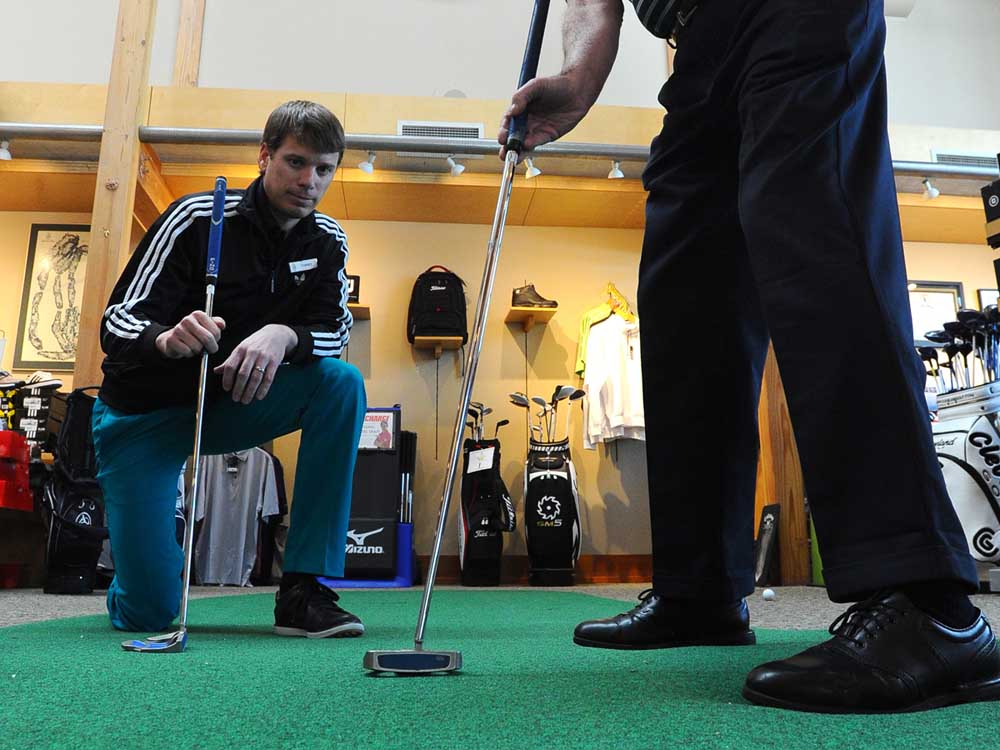Anchored putters a thing of the past
Published 12:00 am Monday, January 11, 2016

- Photos by Ryan Brennecke / The BulletinAwbrey Glen associate head professional Tommy Berg, left, watches as Richard Gallio demonstrates an anchored stroke with his old, long putter Thursday afternoon at the Awbrey Glen Golf Club. Gallio has had to make the switch to a non-anchored stroke with his new putter (held by Berg) to comply with Rule14-1b, which banned the use of anchored strokes on Jan. 1.
Three years ago, golf’s governing bodies instituted a rule change that, unless it affected you and your putting stroke directly, you probably did not realize took effect on New Year’s Day.
But for those who had been using a longer putter anchored to the body, estimates in 2013 were 2 to 4 percent of golfers, preparing to abandon the stroke they have been using for years became a priority long before Jan. 1.
The new rule — 14-1b in the USGA’s Rules of Golf — states that “in making the stroke the player must not anchor the club directly or by use of an anchor point.” The penalty for doing so is two strokes in stroke play, loss of the hole in match play.
To comply with the new rule, two Central Oregon golfers last summer began the transition to a different putter and stroke.
The “y” word
Richard Gallio, a member at Awbrey Glen in Bend, and Tom Liljeholm, who plays at Meadow Lakes in Prineville, both had the same issue that was abated with the use of the anchored stroke.
The dreaded “y” word, (it rhymes with “pips”). It is similar to the “sh” word (rhymes with “yanks”) for those who play the game. Golfers do not like to speak of such things.
It is an affliction that has ended careers on the PGA Tour, and has caused many an amateur golfer, especially seniors, to give up the game entirely. It is described as an involuntary glitch, or twitch of the muscles during the putting stroke, especially on short putts.
For Gallio, 73, his trouble began about five years ago, and the move to the anchored stroke was the only thing that helped. Prior to switching to the longer putter, the right handed player tried a left-hand low grip and the claw grip with his conventional putter, but the different grips would help only for a little while.
“I tried various things, mostly changing my grip positions, and one of the pros at Awbrey Glen recommended I try the long putter,” Gallio, a 14 handicap said. “By taking the left hand out (of the stroke), I was able to eliminate the problem.”
With the top of the club anchored by the left hand, Gallio’s new stroke was controlled by his right hand, not the norm for a right-handed golfer.
“His top hand (the left) was at or near his chest and his lower hand (the right) was a good 18 inches to 2 feet below,” said Tommy Berg, Awbrey Glen associate head professional, who has been working with Gallio on his putting. “The right hand was controlling the stroke instead of the left.”
When making the switch over the summer, Berg and Gallio decided, for familiarity, to keep the same PING putter head on the standard putter as he had on the long putter. Still, the change has not come easy to Gallio.
“I had to learn how to putt all over again,” he said. “When I have played (with the new putter and stroke), I have not had an occurrence of the yips so far. My putting was probably a little worse that it was with long putter, but I think that was from learning the new style.
“That’s why I started in July, to get some time in before the ban took effect. At least I would have a little experience before the season starts next spring.”
But the true test will come when Gallio is on the course in the spring and has that first crucial 5-footer, Berg said.
“It won’t be until he gets out in his regular game and has a big pressure putt … that’s when he will find out,” Berg noted. “We’ll put him on the practice green with some pressure situations, making five in a row, or 10 in a row from short distances, to see how he’s coming along.”
Gallio does not think he had an unfair advantage with the anchored stroke, and neither did his playing partners, who were more concerned with how he was going to deal with the change.
“I didn’t think rule change was necessary,” Gallio said. “Other players didn’t feel like I had an advantage; more wondered about what I was going to do because they were aware of my yips.
“One of my primary concerns was for the young golfers who had used the anchored putter from the beginning — at a time when we need more golfers. I was more concerned that we may lose those players, when we needed to maintain and grow the game.”
Low handicapper
Former golf professional and accomplished amateur player, Tom Liljeholm had used the longer putter and anchored stroke much longer. He first picked one up and began using it in 1988 — and is not pleased about being forced to switch to the unanchored stroke.
“I’m not happy with the rule change,” Liljeholm, 78, said. “I don’t see where it is that much of an advantage. I think the USGA is making rules they don’t have to. They feel like they do — but I feel it’s not a necessary rule.”
Liljeholm, who was a professional and owned a course outside of Portland from the 1960s to the 1980s, quit playing in competitive tournaments for a number of years. When he came back to golf, he got his amateur status back and qualified for the U.S. Senior Open twice, while also winning major amateur tournaments in the Northwest — all while using the anchored stroke.
“When I came back after not playing tourneys for 18 years, my putter didn’t come back with me,” said Liljeholm, now a 5 handicap. “The yips drove me to the longer putter. Putting was a strong part of my game when I was younger, but (when he returned to competitive golf) the game wasn’t any fun — anchoring made my stroke much more relaxed.”
He sees the rule change as similar to the banning of the croquet style of putting, used by popular touring professional Sam Snead in the 1950s and ’60s.
“They made the rule that you couldn’t putt between your legs anymore,” Liljeholm recalled. “I believe there would have been a lot more people putting that way if they hadn‘t changed the rule. It allowed people to be better putters.”
Like Gallio, Liljeholm began working on the switch last summer, using a standard putter with a cross-handed grip for longer putts, and the longer putter (unanchored) for the short putts.
“It’s a little harder (using the unanchored stroke),” Liljeholm said. “When you use the longer putter it is naturally going to be touching your body in some way. Now that you have to hold it away from your body, it’s going to be much more difficult.”
So far he has been unsatisfied with the results — so much so that he is contemplating giving up the game.
“Since I’ve started with the changeover, I would say my putting has gotten worse,” Liljeholm said. “I don’t know what I’m going to do. I’ve been playing long enough that I might just hang it up … frustration with my putting makes me think.
“I’m still feeling yippy with the new stroke. I’m never going to eliminate it completely.”
— Reporter: 541-617-7868, kduke@bendbulletin.com






